-
Study 2011: Comparison of advertising analysis of CaptchaAd and Medium Rectangle
Key Findings:
- The use of CaptchaAds lead to a brand recognition rate of 72%.
- Regarding the brand name, CaptchaAds has a 4,2-times higher advertising impact than Medium Rectangles, which are being shown isolated for a duration of 11 seconds.
- Regarding the brand name, CaptchaAds has a 10,3-times higher advertising impact than Medium Rectangles, which are indicated above a reCAPTCHA.
- After the submission of the product name in the CaptchaAd still 52% of the test persons could remember the correct wording. The other tested advertising formats achieved a reminding rate of under 2%.
Composition of the study
The study examines the new online advertising format of the company CaptchaAd GmbH up to its’ advertising impact in comparison to well established, modern advertising forms. A distinction is made between brand- and product cognition. Over 250 test persons watched a random commercial of our cooperation partner MITSUBISHI MOTORS. This commercial was either above a conventional reCAPTCHA, or a Medium Rectangle or a CaptchaAd integrated into a personality test.
The study 2011 was realized 2011 by the academy Fresenius Köln, University of Applied Sciences.
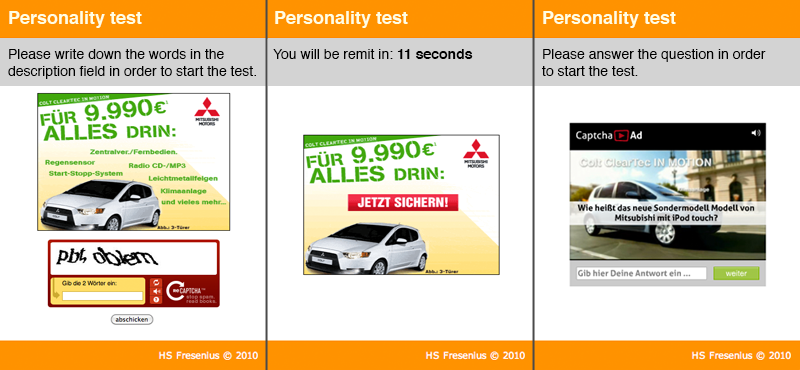
Advertising formats (from left to right): Medium Rectangle above a ReCAPTCHA; Medium Rectangle with a display duration of 11 seconds; CaptchaAd commercial
Brand recognition
The study proves, 72 percentage out of the test persons, who solved a CaptchaAd, could name the brands correctly, which where shown in the commercials before. Therefore the advertising impact improved by over 420 percent in comparison to the established advertising form, the Rectangles, where only 17 percent managed to do so. Compared to conventional reCAPTCHAs combined with commercials, CaptchaAds boosted the impact even up to 10,3 times. ReCAPTCHAa now only reach a 7 percent hit rate.
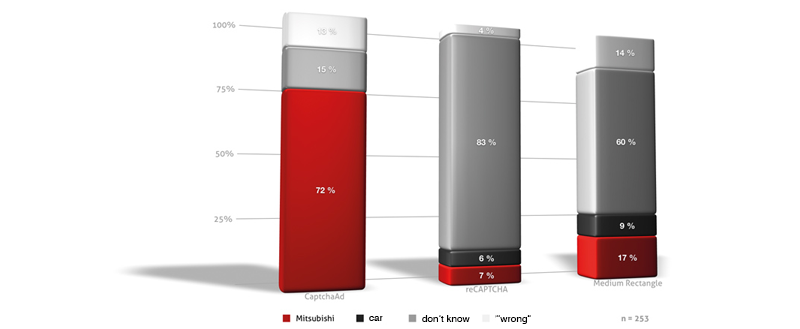
brand recognition
Product recognition
In terms of product cognition CaptchaAds can, too, convince highly. In addition to the brand 52 percent of the test persons did not only determine the brand name correct but also the specific product. Thus CaptchaAd comes with an obvious overall higher advertising impact in terms of brand and product cognition, which outmans the other online advertising forms significantly.
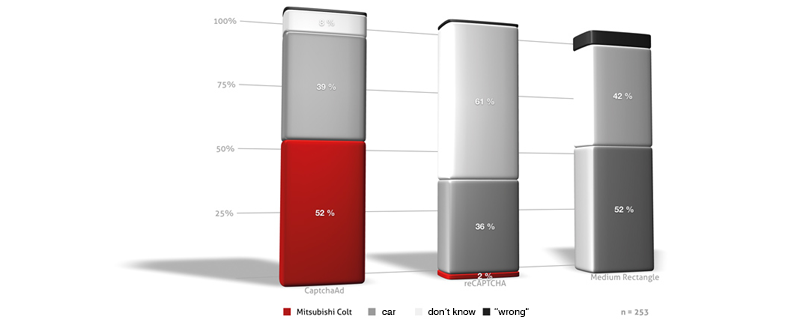
product recognition
Conclusion: CaptchaAd comes with an obvious overall higher advertising impact both in terms of brand and product cognition.The study was realized by the academy Fresenius, Köln –specialist division economy and media through the assistant professor Alexander Hachmann; with support of Alexis Maggoutas, Anna Nowack, Florian Schoen, Ina Schüttler and Pina Steinhauer.
Your contact person for all further questions:Jan Philipp Hinrichs
Founder & CEO
[email protected]
-
Study 2013: Comparison of advertising analysis of CaptchaAd and and Pre-Roll Ad
Key Findings
- 3,4-times higher product remembrance than the conventional Pre-Roll Video Ad
- higer brand remembrance
- interactivity of the users boosts the remembrance performance for the advertising message
- conscious cognition of the advertising message through the uncomplicated Question-Answer-Principle
- innovative & positive perceived overleap function
- the response is proof, that the ad was watched
(acc. to the second study 24% of the users are distracted during the commercial)
Composition of study
The study realized at academy Fresenius Köln „Der neue Werbehorizont für das bewegte Bild – Vergleichende Werbewirkungsanalyse von Online Advertising am Beispiel von CaptchaAds und Pre-Roll Video Ads“ compared the advertising impact of CaptchaAds with the impact of established Pre-Roll Video Ads.
In the foreground of the investigation stood the advertising impact of both formats concerning their remembrance performance and the user acceptance. The study of march 2013, with overall 568 test persons was realized in cooperation with the advertiser MITSUBISHI MOTORS Germany.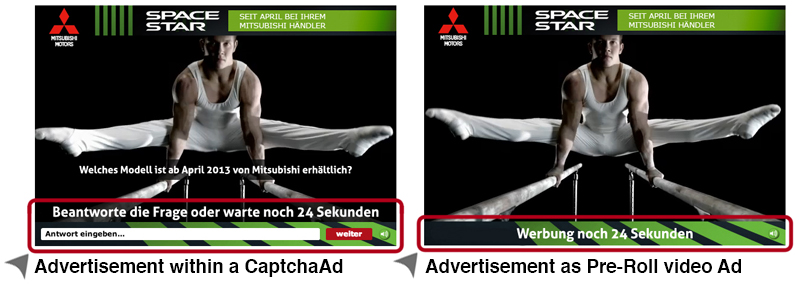
Commercial of the advertiser MITSUBISHI MOTORS compared in advertising media CaptchaAd with interaction importance of user vs. Pre-Roll Video Ad without active involvement of the uses. Product recognition
With 51 percent more than half of the interviewees could answer a unsupported question with the the right name of the advertised product after looking at a CaptchaAd. As for the PreRoll-Ad only 15 percent could do so. Therefore CaptchaAds have a 3,4-times superior advertising impact than PreRoll-Ads on ”unknown” products.
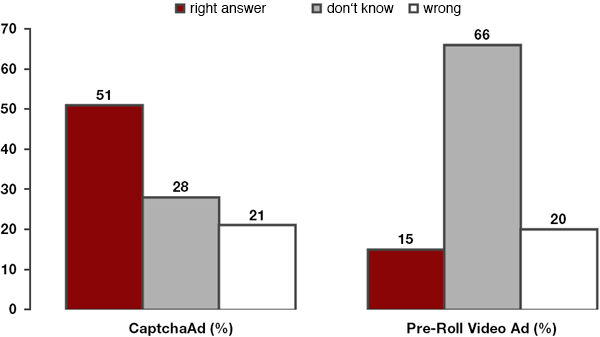
Remembrance of the correct product name, in comparison CaptchaAd and Pre-Roll Video Ad (percentage quotations are rounded). Brand recognition
73 percent of the test persons were able to name the correct automotive brand, which was shown in the commercial, without any help after looking at a CaptchaAd. As for the Pre-Roll Video Ad only 59 percent could do so.
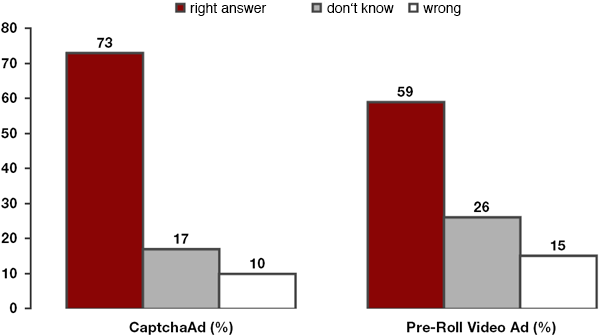
Remembrance of the correct brand, in comparison CaptchaAd and Pre-Roll Video Ad (percentage quotations are rounded). User acceptance of CaptchaAd vs. PreRoll-Ad
Regarding the user acceptance between PreRoll-Ads and CaptchaAds it is shown, that to the greatest possible extent they where seen and rated superimposable.
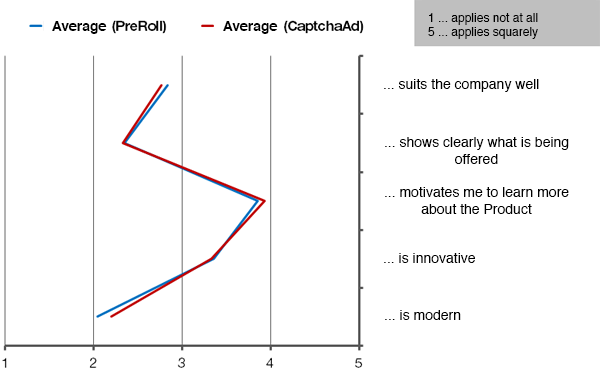
The participants were asked what they think about the advertisement they watched and the advertising format.
Conclusi0n: The video-advertising media CaptchaAd outguns in its’ advertising impact the conventional Pre-Roll Video Ad considerably. The higher advertising impact is achieved by CaptchaAd when regarding identical user acceptance.The study 2013 was realized at the Psychology School of the academy Fresenius Köln in the framework of Alexis Maggoutas, student of business psychology, graduation work under the attendance of his first examiner Alexander Hachmann, assistant professor with specialization in media psychology.
to press release
Your contact person for all further questions:Jan Philipp Hinrichs
Founder & CEO
[email protected]
-
Compared effectivity analysis of PreRoll-Ads, TrueView-Ads and CaptchaAds
Key Findings
- when spending the same budget then CaptchaAds are 3,4-times more efficient than PreRoll-Ads.
- CaptchaAds sind bei gleichem Budget 1,25-times effizienter als TrueView-Ads.
- the acceptance parameter of a CaptchAd is identical with the one of a PreRoll-Ad.
Study CaptchaAd 2013
The study realized in june 2013 through the academy Fresenius Köln in cooperation with MITSUBISHI MOTORS Germany could show that CaptchaAds have a 3,4-times higher advertising impact than PreRoll-Ads.
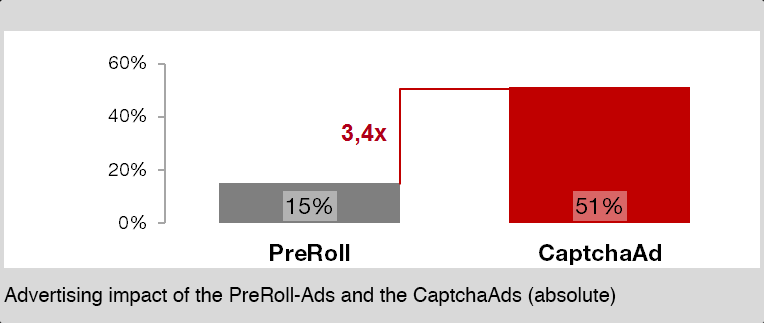
Study thinkinsights with Google 2012
TrueView-Ads offer users the possibility of skipping ads. Advertiser only pay fully watched videos.
Thinkinsights made a study in 2012 in cooperation with Google regarding Top-of-Mind Awareness (TOMA) for TrueView-Ads and PreRoll-Ads. This shows that TrueView-Ads have a 2,8-times higher advertising impact than PreRoll-Ads.
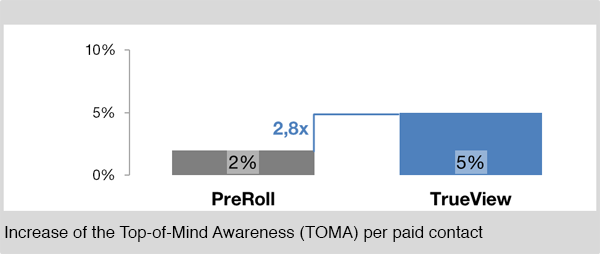
Effectivity analysis
Trough a Meta-Analyse of both studies, an effectivity analysis of all three advertising formats can be executed. In oder to achieve an advertising impact of 1.000 CaptchaAd-Impressions it must be replaced at least either by 3.400 PreRoll-Impressions or 1.250 TrueView-Impressions.
In monetary units: If we suppose a PreRoll-TKP of 15€ one needs 3.400 x 0,015€ = 51,00€ to invest in order to achieve the advertising impact of 1000 CaptchaAd-Impressions erreicht. In the converse argument this means until a CaptchaAd-TKP of 51,00€, CaptchaAd is the better advertising format.
 Conclusion: The video advertising media CaptchaAd outguns in its’ advertising impact the conventional Pre-Roll Video Ad about 3,4-times and the TrueView-Ad about 1,25-times. If there were TKP-offers for all 3 advertising medias it would be possible to determine, which of these advertising formats has the highest effectivity by multiplying with the factors 3,4 and 1,25.Your contact person for all further questions:
Conclusion: The video advertising media CaptchaAd outguns in its’ advertising impact the conventional Pre-Roll Video Ad about 3,4-times and the TrueView-Ad about 1,25-times. If there were TKP-offers for all 3 advertising medias it would be possible to determine, which of these advertising formats has the highest effectivity by multiplying with the factors 3,4 and 1,25.Your contact person for all further questions:Jan Philipp Hinrichs
Founder & CEO
[email protected]
